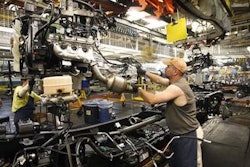For many food and beverage manufacturers, improving the efficiency of their organization is a top priority, second only to increasing sales. Competing in a high volume/low margin industry requires that every aspect of the company operate at peak efficiency. Aberdeen Group considers a manufacturer as best-in-class based on the following metrics:
- 99% production compliance
- 89% overall equipment effectiveness (OEE)
- 98% on-time and complete shipments
- 3.7 hours response time to non-conforming shipments
- +9% operating margin versus corporate plan
Even small changes can result in noticeable savings. Producing less waste, employing less labor and operating equipment more efficiently are examples of incremental improvements that yield results. But the challenge is how to determine areas for improvement. Without access to real-time information, it can be difficult to establish a baseline, much less identify what changes need to be made. The ability to turn data into actionable insight is a key differentiator between industry leaders and all others. Three core solutions are at the heart of many leaders in the food and beverage industry: Enterprise Resource Planning (ERP), Enterprise Asset Management (EAM) and Manufacturing Execution System (MES).
Efficiency
ERP manages the efficiency of the entire organization. It is the system of record and control, the single source of truth that supports almost every department. According to Aberdeen Group, 80 percent of best-in-class companies utilize ERP to manage products and manufacturing.
This system is the key to addressing one of the top concerns for the food and beverage industry — food safety and traceability. Food safety is an issue for consumers, as well as manufacturers. The number of food recalls rose 22 percent in 2016, and the two major reasons were undeclared allergens and listeria contamination. The cost of recalls can be staggering. The direct costs per recall can range from hundreds of thousands of dollars to hundreds of millions. Damage to the brand is more difficult to calculate, with more than half of consumers stating they would switch to another food brand upon learning of a recall. A fully integrated ERP with bidirectional lot traceability tracks material from supplier to customer, and throughout the production process, providing information about where ingredients within any given batch originated, and also where that batch went. With this information readily available, manufacturers can respond quickly to minimize the potential harm to consumers, and the negative impact on the company, its reputation and its customers.
Reliability
EAM provides efficiency of engineering. Manufacturers invest heavily in their equipment, and so it is vital that those assets are reliable and have the ability to operate at peak performance. Food and beverage is an industry with continuous processes; if there is a pause in the process, there is potential for a great deal of wasted product and downtime. Aberdeen Group reports that 79 percent of best-in-class manufacturers invest in EAM technology, moving away from “break/fix” maintenance to a more predictive approach through preventive maintenance and asset analytics.
The costs associated with the traditional approach of “break/fix” go beyond parts and labor. When equipment fails, production stops, and every minute of lost production equals lost revenue. Deteriorating equipment can also have an impact on product quality. For example, testing equipment that fails to detect potential pathogens will result in a recall that can erode consumer trust in the brand. Best-in-class organizations experience 21 percent higher OEE with 15 percent lower unscheduled downtime, and the majority have achieved these results through technology. Real-time visibility into production and asset performance data allows manufacturers to monitor the condition of equipment and provide valuable information to decision makers, which translates to actionable intelligence to predict and plan maintenance activities across the company’s assets. Best practices configured into the system provide the basis for continuous improvement to provide reliability while increasing utilization of equipment and decreasing cost.
Productivity
MES allows for efficiency of production. Manufacturers must beat the competition in cost, quality and getting new products to market faster. Having reliable equipment with minimal unplanned downtime is important, but having efficient production while operating is also key. Best-in-class organizations do so by automating and optimizing their manufacturing processes, and 56 percent use MES as a key part of their strategy.
Once more, visibility is critical. The ability to see data in real time and to enable operators to immediately act upon it is vital when every opportunity for improvement counts. The system allows users to identify bottlenecks, analyze causes of production downtime and track the true costs of production. Factory floor teams are able to implement immediate reviews, make real-time adjustments and measure immediate performance improvements. MES can also assist with regulatory compliance by ensuring that all tasks are completed, performed in the proper order and done by properly trained operators, as well as maintaining all necessary documentation.
Next Steps
Individually, these three solutions allow an organization to improve operational efficiencies and reduce costs; when integrated, it is possible to rise to the next level, to move toward best-in-class.
Jack Payne is VP, Product Management & Solutions Consulting for Aptean






















